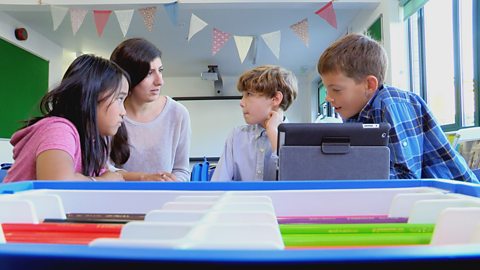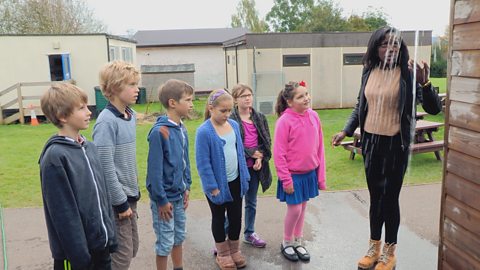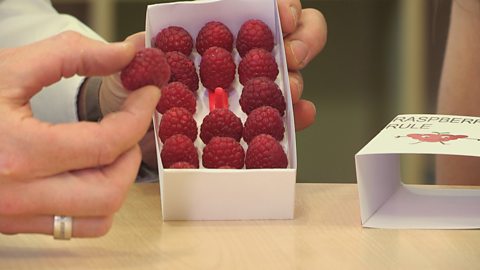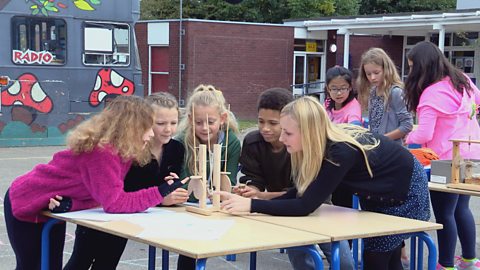YASMIN ALI: Hi, I'm Yasmin, and I'm a mechanical engineer working on North Sea gas development. Today, I've come to a swimming pool to help pupils from Beavers Community Primary School in London make a bag that meets the needs of the local swimming team.
This is Ella and Millie from the Great White swimming team, so you can ask them questions to help you design the swimming bag.
ABBEY: Roughly what size do you want your bag?
ELLA: I've got a medium size bag at the moment, which is good because I can fit all my stuff in and it doesn't get too heavy.
MILLIE: My bag's too small at the moment.
GUNEET: What colour would your bag be?
ELLA: Well, it doesn't necessarily matter but maybe like my favourite colour, so orange.
MILLIE: My favourite colour's pink.
BANMEET: What things do you put in your bag?
ELLA: Well, I've got my towel, my swimming costume, my goggles and my shampoo and conditioner.
TYRESE: How many parts do you need in your bag to separate your stuff?
MILLIE: I think it would be quite good to have two because I can put my swimming costume and goggles in one and a towel in the other.
YASMIN: So we now have a good idea of the specifications needed for the swimming bag. How many compartments did they ask for?
ALL: Two.
YASMIN: So we should have two compartments.
LEILA: We shouldn't make the bag too big because we have to think about the lockers and how big they are.
GUNEET: It should be a strong material so that it doesn't break or anything.
TYRESE: I think the bag should be waterproof.
YASMIN: We split into two teams to sketch our ideas. One team has chosen a drawstring design and the other has gone for a backpack. These are your final two designs. Which one do you think would meet the requirements of the swimmers?
DAPHNE: It's good because it has two pockets like the swimmer said.
YASMIN: The backpack design has a large pocket at the top and four smaller compartments below. Which one do you think might be easier to make?
LEILA: I think this one will be easier to make because it's not too complicated. If we have too many sections it's going to get really complicated and in the end we might not be able to make it on time.
YASMIN: So it's the drawstring design that gets the thumbs up. But we like the pocket idea on the backpack and we'll try to incorporate this into our prototype. Do you think this bag meets the needs and requirements of the swimmers that we met earlier today?
CHILDREN: Yes.
YASMIN: Yeah?
ABBEY: We're going to make a drawstring bag and it's going to have a box pocket with a flap over the pocket.
YASMIN: What dimensions are you planning on using for the bag?
BANMEET: For the width 64, and the height 60, because by the time we sew it in it will become smaller. For the box pocket, we thought to make it half so we did the height 30 and the width 32.
YASMIN: We've got all these materials to look at, so which ones do you think would be good for the bag?
ABBEY: I think we are going to choose this one because it's a drawstring material and it's really strong.
TYRESE: We like this because it's waterproof and it's very strong and it won't rip.
YASMIN: What part of the bag would you use that for?
TYRESE: The inside.
BANMEET: I don't think our group would like this material because it's not one of the girls' favourite colours, it's a bit too dark. Also, as you can see, it can rip easily and the thread comes out. It won't be good for a bag.
LEILA: I think we're going to use this one because it's pink. It will be nice to add a little bit of colour to the bag because if we're going to be using the waterproof material, which is white, it will look nice to add a bit of colour.
YASMIN: This bag looks really amazing, so can you talk me through the different features that it has?
ABBEY: So, there's a pocket and we've got a flap to it.
LEILA: So, the inside of the bag as you can see is quite big as one of the girls from the swim team said that they wanted their bag to be a bit bigger.
YASMIN: And the lining?
LEILA: The lining is waterproof so your clothes don't get wet.
YASMIN: And you've gone for a swimming pattern with the flip flops there, that's really good.
GUNEET: Here is your bag that we made for you.
MILLIE: Thank you, it's really nice, I really like the pockets and I like the fact it's waterproof and I like the colour. It's much bigger than the one I've got at home.
YASMIN: We've achieved all of our swimming bag design aims. Well done teams!
Video summary
Engineer Yasmin Ali helps a team of children to research, design and make a bag for a member of the local swimming team.
Having researched the key design requirements, the children make two possible designs and decide on the most suitable.
They use design software to create their pattern pieces, select suitable fabrics and make their prototype.
This clip is from Design Challenge, a series in which groups of children tackle some difficult creative projects with the help of talented young engineers.
Teacher Notes
This clip could be used to introduce the process of designing a product, and as a prompt for class discussion and learning in areas such as initial research, investigating products, designing and making.
This clip will be relevant for teaching Art and Design and Design and Technology at KS2 in England, KS1 and KS2 in Northern Ireland, Design and Technology at KS2 in Wales and at 2nd Level in Scotland.
How to design a nightlight for a toddler. video
Engineer, Yasmin Ali, helps a team of children design and make a nightlight for a toddler.

How to design and make a rainwater harvester. video
Engineer, Marie Adeyemi, helps a team of children design and make a rainwater harvester.

How to design packaging for soft fruit using 2D and 3D software video
Marie Adeyemi helps a team of children to design some packaging for soft fruit.

How to design and make a moving shop window display. video
Engineer, Abbie Hutty, helps a team of children to design a moving shop window display.

How to design a portable bird hide for children to use at a nature reserve. video
Engineer, Abbie Hutty, helps a team of children to design a portable bird hide.
